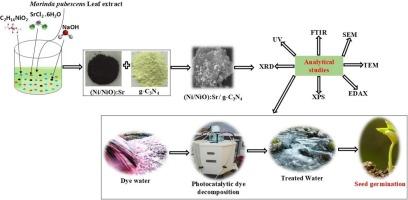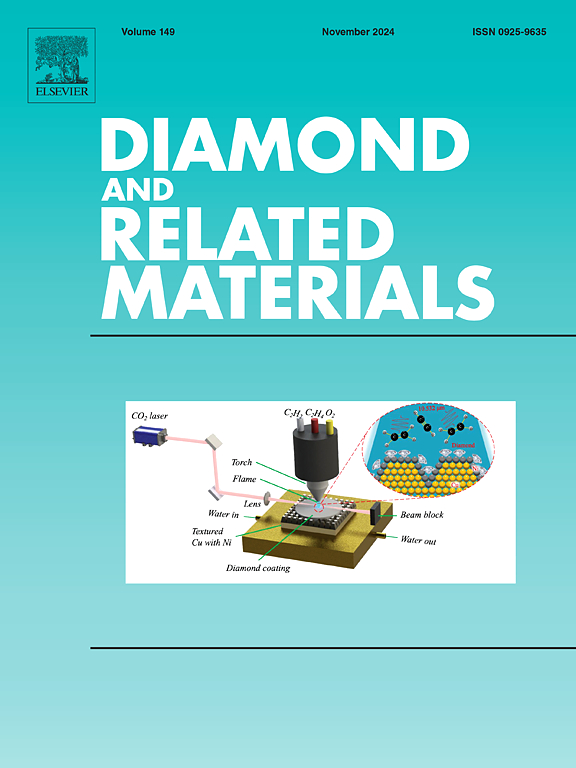g-C3N4 与巴戟天叶提取物介导的 Sr 掺杂 Ni/NiO 纳米复合材料对光催化染料解毒的影响:种子发芽试验证实
IF 4.3
3区 材料科学
Q2 MATERIALS SCIENCE, COATINGS & FILMS
引用次数: 0
摘要
将碳质二维材料 g-C3N4 添加到掺杂锶的 Ni/NiO 中,利用巴戟天叶提取物合成了绿色溃散纳米复合材料 (Ni/NiO):Sr/g-C3N4。合成材料被用作光催化剂,用于完全解毒纺织、皮革和造纸工业中广泛使用的合成有毒染料亚甲基蓝(阳离子)和玫瑰红(阴离子)。纳米复合材料的效率与 Ni/NiO 和 Ni/NiO:Sr 样品的效率进行了比较。通过 XRD、SEM、TEM、EDAX、FTIR、UV-Vis-NIR 和 XPS 分析验证了复合材料的形成。与(Ni/NiO):Sr(72% 和 65%)和(Ni/NiO)(83% 和 70%)相比,掺杂 Sr 的(Ni/NiO)/g-C3N4 纳米复合材料在辐照 45 分钟内对 MB 染料和 RB 染料的光催化效率分别达到 98% 和 94%。在纳米复合材料中加入 g-C3N4 降低了带隙(从 Ni/NiO 的 3.9 eV 降至 (Ni/NiO):Sr/g-C3N4 的 2.9 eV),使其能够用作可见光响应型光催化剂。该材料的稳定性已通过再循环测试得到证实。为了找出光催化过程中的活性物种,进行了捕获试验,结果表明在降解染料分子时,OH⁎ 自由基比其他三种(e-、h+ 和 O2-)自由基更主要。通过使用马齿苋种子进行种子发芽试验,证明了试验染料溶液完全解毒。与包括对照组在内的所有其他样品相比,经(Ni/NiO):Sr/g-C3N4 纳米复合材料处理的水样的种子发芽率更高。因此,这种利用巴戟天植物叶提取物合成的环保型纳米复合材料显示了其通过光催化过程高效解毒有机染料的潜力。本文章由计算机程序翻译,如有差异,请以英文原文为准。

Effect of nanocomposite partnering of g-C3N4 with Morinda pubescens leaf extract mediated Sr doped Ni/NiO on the photocatalytic dye detoxification: Confirmation by seed germination test
A carbonaceous 2D material g-C3N4 was added as the composite partner to Sr doped (Ni/NiO) to synthesize a green routed nanocomposite (Ni/NiO):Sr/g-C3N4 using the leaf extract of Morinda pubescens. The synthesized material was employed as a photocatalyst towards complete detoxification of synthetic toxic dyes methylene blue (MB-cationic) and rose bengal (RB- anionic) widely used in textile, leather and paper industries. The efficiency of the nanocomposite was compared with those of Ni/NiO and Ni/NiO:Sr samples. The composite formation was verified through XRD, SEM, TEM, EDAX, FTIR, UV–Vis-NIR and XPS analyses. The Sr doped (Ni/NiO)/g-C3N4 nanocomposite showed significant higher photocatalytic efficiency of 98 % for MB dye and 94 % for RB dye compared to (Ni/NiO):Sr (72 and 65 %) and (Ni/NiO) (83 % and 70 %) within 45 min of irradiation. The inclusion of g-C3N4 in the nanocomposite reduces the band gap (from 3.9 eV for Ni/NiO to 2.9 eV for (Ni/NiO):Sr/g-C3N4), enabling it to serve as visible light responsive photocatalyst. The stability of the material was confirmed by conducting re-cycle test. To find the role of active species involved in the photocatalysis, trapping test was conducted, the result of which showed that OH⁎ radicals predominate over the other three species (e−, h+ and O2−) in degrading the dye molecules. The attainment of complete detoxification of the test dye solutions was demonstrated by conducting seed germination test using Amaranthus viridis seeds. A superior seed germination was observed in the case of water sample treated by (Ni/NiO):Sr/g-C3N4 nanocomposite compared to all the other samples including the control. Thus, this eco-friendly nanocomposite synthesized using Morinda pubescens plant leaf extract shows its potential for efficient detoxification of organic dyes through photocatalytic process.
求助全文
通过发布文献求助,成功后即可免费获取论文全文。
去求助
来源期刊

Diamond and Related Materials
工程技术-材料科学:综合
CiteScore
6.00
自引率
14.60%
发文量
702
审稿时长
2.1 months
期刊介绍:
DRM is a leading international journal that publishes new fundamental and applied research on all forms of diamond, the integration of diamond with other advanced materials and development of technologies exploiting diamond. The synthesis, characterization and processing of single crystal diamond, polycrystalline films, nanodiamond powders and heterostructures with other advanced materials are encouraged topics for technical and review articles. In addition to diamond, the journal publishes manuscripts on the synthesis, characterization and application of other related materials including diamond-like carbons, carbon nanotubes, graphene, and boron and carbon nitrides. Articles are sought on the chemical functionalization of diamond and related materials as well as their use in electrochemistry, energy storage and conversion, chemical and biological sensing, imaging, thermal management, photonic and quantum applications, electron emission and electronic devices.
The International Conference on Diamond and Carbon Materials has evolved into the largest and most well attended forum in the field of diamond, providing a forum to showcase the latest results in the science and technology of diamond and other carbon materials such as carbon nanotubes, graphene, and diamond-like carbon. Run annually in association with Diamond and Related Materials the conference provides junior and established researchers the opportunity to exchange the latest results ranging from fundamental physical and chemical concepts to applied research focusing on the next generation carbon-based devices.
 求助内容:
求助内容: 应助结果提醒方式:
应助结果提醒方式:


